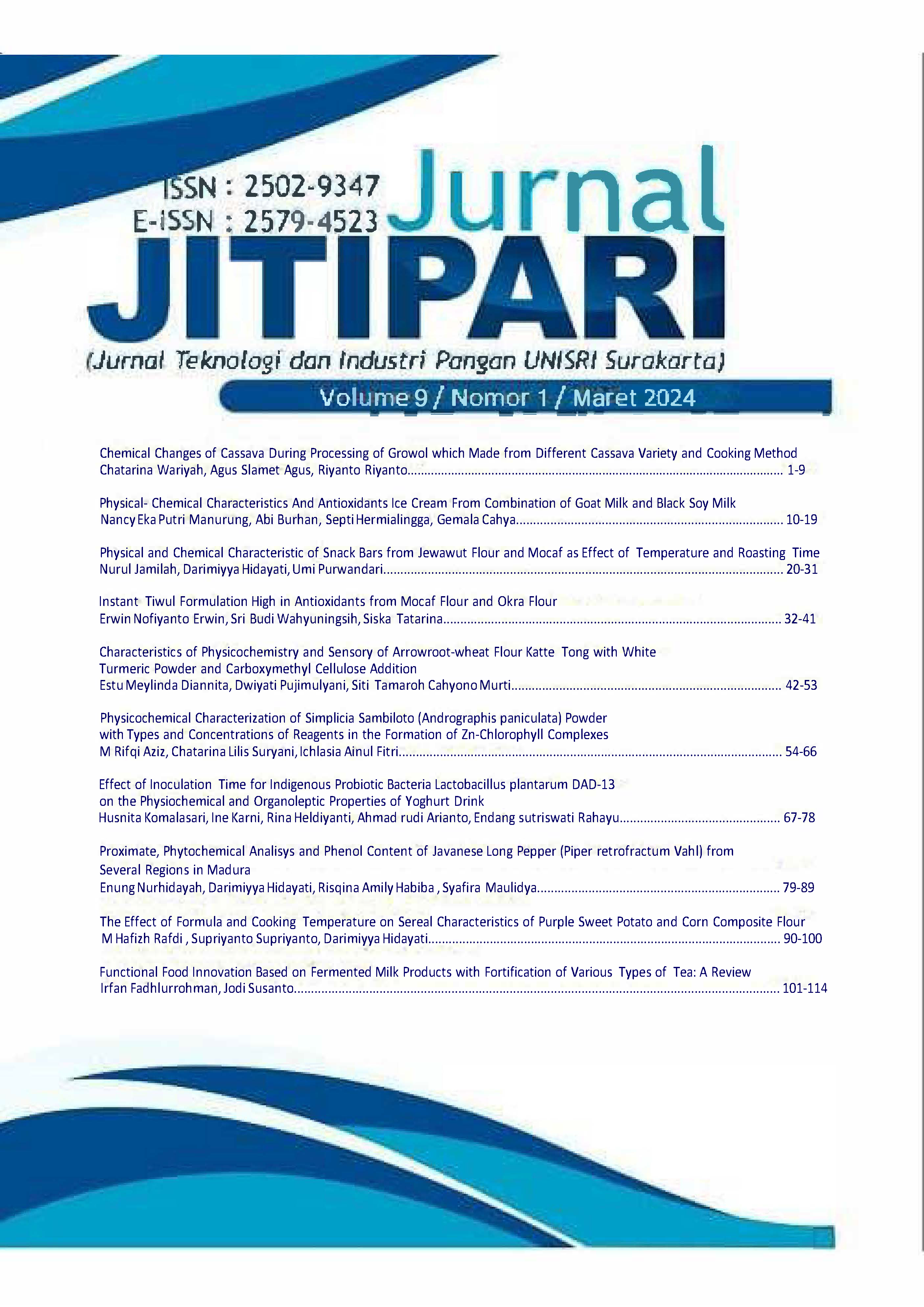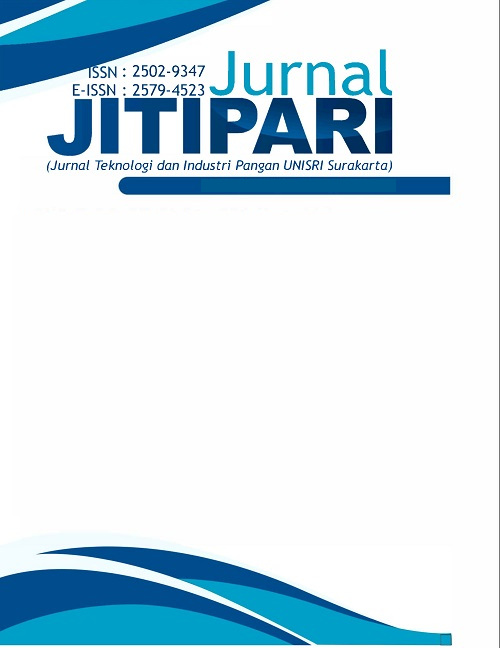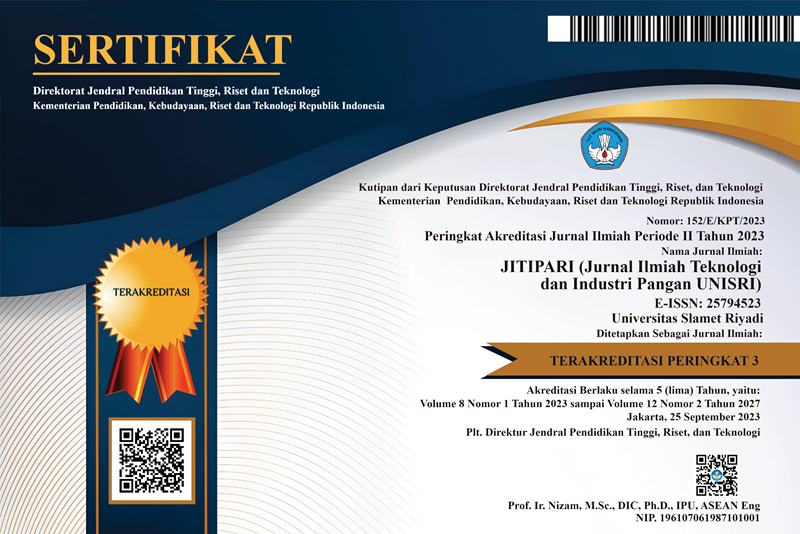Physicochemical Characterization of Simplicia Sambiloto (Andrographis paniculata) Powder with Types and Concentrations of Reagents in the Formation of Zn-Chlorophyll Complexes
Karakterisasi Fisikokimia Bubuk Simplisia Sambiloto (Andrographis Paniculata) dengan Jenis dan Konsentrasi Reagen dalam Pembentukan Kompleks Zn-Klorofil
DOI:
https://doi.org/10.33061/jitipari.v9i1.8982Abstract
During the process of making sambiloto simplicial which involves heat, it can cause degradation of chlorophyll. Increasing the stability of chlorophyll can be done by forming Zn-chlorophyll complexes with metals which are be able to form complexes where more stable than Mg such as by using Zn. The aim of this research is to determine how the physical and chemical characteristics of the bitter simplicia powder produced are influenced by the type of reagent and the concentration of the reagent when heated in an oven. Simplicia bitter powder is made through a sorting, grinding and sieving process. Next, the zinc chloride and zinc acetate reagents were mixed with concentrations of 0, 200, 300, 400, and 500 ppm, and then dried. The results showed a real effect (p value <0.05) of the interaction between the types of ZnCl2 and Zn acetate reagents and the reagent concentration on color intensity, color stability, water content, ash content and chlorophyll content. The higher the concentration of ZnCl2 and Zn acetate, the higher the water content, ash content, chlorophyll content, L*, and -a*, while b* and ∆E decrease. At a concentration of 500 ppm ZnCl2 showed an increase in water, ash, chlorophyll, ∆E, L*, and a* content while b* decreased. Meanwhile, Zn acetate 500 ppm moisture content, ash content, chlorophyll content, L*, and ∆E decreased, while a* and b* increased. Sambiloto simplicia powder which has the highest chlorophyll content is Zn acetate 400 ppm, with characteristics of water content 6.81% ww, ash content 15.74% ww, total chlorophyll 397.97 mg/100 g ww, green color intensity (-a) -2.93, and ∆E 5.48.
References
AOAC, (2012). Official methods of analysis of AOAC International, 19th Edition. Apforgen.
Aryanti,F., Aininu.N., Fathia M.W. (2016). Ekstraksi dan karakterisasi klorofil dari daun suji (Pleomele angustifolia) sebagai pewarna pangan alami. Jurnal Aplikasi Teknologi Pangan, 5, (4)
Atmawikarta, A. (2009). Kampus gizi. Kompas. Media Nusantara. Jakarta.
Az-Zahra E.P. (2023). Pengaruh jenis dan konsentrasi reagen pembentuk kompleks metalloklorofil terhadap karakteristik bubuk simplisia sambiloto (Andrographis paniculata) dengan perlakuan autoklaf. Skripsi. Universitas Mercu Buana Yogyakarta.
Canjura, F. L., Watkins R. H., and Schwartz S. J. (1999). Color improvement and metallochlorophyll complexes in continuous flow aseptically processed peas. Journal Food Science, 64. 987-990.
Dalimunthe, A. (2009). Interaksi sambiloto (Andrographis paniculata). Departemen Farmakologi Fakultas Farmasi Universitas Sumatera Utara. Medan.
Delgado-Vargas, Francisco, Paredes-Lopez, Octavio. (2003). Natural colorants for food and nutraceutical Uses. USA: CRC Press.
Departemen Kesehatan Republik Indonesia. (1983). Pemanfaatan tanaman obat. Direktorat Jenderal Pengawasan Obat dan Makanan. Jakarta.
Departemen Kesehatan Republik Indonesia. (1985). Cara pembuatan simplisia. Jakarta: Departemen Kesehatan Republik Indonesia.
Departemen Kesehatan Republik Indonesia. (2000). Parameter standar umum ekstrak tumbuhan obat. Jakarta: Departemen Kesehatan Republik Indonesia.
Departemen Kesehatan Republik Indonesia. (2008). Farmakope herbal Indonesia (Edisi I). Jakarta: Departemen Kesehatan Republik Indonesia.
Dewanto, V., Wu, X,. and Liu, R. H. (2002). Processed sweet corn has higher antoxidat activity. Jurnal of agricultural and food chemistry, 50 (17), 4959-4964.
Ernaini, Y., Agus, S., dan Rinto. (2012). Pengaruh jenis pelarut terhadap klorofil dan senyawa fitokimia daun kiambang (Salvinia molesta Mitchell) dari perairan rawa. Jurnal Fishtech, 1.1-12.
Fajar A, I. Ratna, dan N.D. Eko. (2014). Stabilitas Ekstrak Kasar Pigmen Klorofil, Beta karoten, dan Caulerpin Alga Hijau Caulerpa racemosa pada Suhu Penyimpanan yang Berbeda. Jurnal Pengolahan dan Bioteknologi Hasil Perikanan, 3 (1). 1-10.
Humphrey AM. (2004). Chlorophyll as a color and functional ingredient. Journal of Food Science. 69(5): C422-C425.
LaBorde, L. F. and von Elbe J. H. (1990). Zinc complex formation in heated vegetable purees. Journal Agriculture Food Chemistry, 42. 1100-1103.
Melwita, E dan Effan, K. (2014). Pengaruh waktu hidrolisis dan konsentrasi H2SO4 pada pembuatan asam oksalat dari tongkol jagung . Jurnal: Teknik Kimia. 20 (2).
Ngamwonglumlert, L., Devahastin, S. and Chiewchan, N., (2017). Natural colorants: pigment stability and extraction yield enhancement via utilization of appropriate pretreatment and extraction methods. Critical Reviews in Food Science and Nutrition, 57 (15). 3243–3259.
Nikolaeva, M.K., Maevskaya, S.N., Shugaev, A.G., dan Bukhov, N.G., (2010). Effect of drought on chlorophyll content and antioxidant enzyme activites in leaves of three wheat cultivars varying in productivity. Russian Journal Plant Physl. 57: 94-102.
Nurusholah T, F.M. Widodo, dan I. Ratna. (2014). Pengaruh perbedaan penambahan konsentrasi ZnCl2 dalam ekstrak kasar pigmen klorofil rumput laut sargassum terhadap stabilitasnya. Jurnal Pengolahan dan Bioteknologi Hasil Perikanan. 3(1), 89-97.
Permatasari,N,A & Afifah, Fitri. (2020). Pembuatan dan pengujian stabilitas bubuk pewarna alami dari daun bayam merah (Alternanthera amoena voss.). 8 (1), 409-422.
Phaniendra, A., Jestadi, D. B. and Periyasamy, L., (2015). Free radicals: properties, sources, targets, and their implication in various diseases. Indian J Clin Biochem, 30 (1), 11-26.
Putra, D. A. (2023). Pengaruh konsentrasi Zncl2 dan cara pemanasan dalam pembentukan komplek metalloklorofil terhadap sifat fisik dan kimia bubuk simplisia sambiloto (Andrographis paniculata). Skripsi. Universitas Mercu Buana Yogyakarta.
Putri, W.D.R., Elok ,Z., dan N. Sholahudin. (2012). Ekstraksi pewarna alami daun suji, kajian pengaruh blanching dan jenis bahan pengekstrak. Jurnal Teknologi Hasil Pertanian. 4(1) : 13 – 24.
Rachmawati W.,dan Liska R. (2020). Potensi daun singkong sebagai pewarna makanan alami. Pharmacoscript, 17(1).27-32.
Rohmat, N., Ibrahim, R., & Riyadi, P. H. (2014). Pengaruh perbedaan suhu dan lama penyimpanan rumput laut sargassum polycystum terhadap stabilitas ekstrak kasar pigmen klorofil. Jurnal Pengolahan Dan Bioteknologi Hasil Perikanan. 3(1). 118–126.
Saadilah M., Rostiati R., dan Syahraeni K. (2018). Karakteristik kimia tepung biji kelor (Moringa oleifera iam.) dari berbagai ketinggian tempat tumbuh. e-J.Agrotekbis. 6 (1). 100 –108.
Seafast. (2012). Pewarna Alami Untuk Pangan; Jakarta.
Suryani. (2020). Pengaruh variasi jenis pengering terhdap karakter fisik, kimia dan antioksidan tepung pandan wangi. Yogyakarta : UGM.
Udiarta P., Eko N.D., dan Romadhon. (2015). Pengaruh penambahan MgCO3 dan ZnCl2 terhadap stabilitas kandungan pigmen klorofil pada mikroalga Spirulina platensis. Jurnal Saintek Perikanan. 10(2). 114-118.
Usman, Fitri, I, A., Suryani, C, L. (2022). Pengaruh jenis medium sumber Zn2+ dan lama blanching terhadap aktivitas antioksidan bubuk Simplisia Sambiloto (Andrographis paniculata). Prosiding Seminar Nasional Mini Riset Mahasiswa. 1(2), 54 – 66.
Wilandika, L., & Vita, P. (2017). Pengaruh suhu terhadap kadar air dan aktivitas air dalam bahan pada kunyit (Curcuma longa) dengan alat pengering electrical oven. Jurnal Metana. 13(2). 37-44.
Yilmaz C, Gokmen V. (2016). Chlorophyll in encyclopedia of food and health. Caballero B, Finglas PM, Toldra F. Waltham (US): Academic Press.
Zvezdanovic, J. B., Petrovic, S. M., Markovic, D. Z., Andjelkovic, T. D., and Andjejkovic, D. H. (2014). Electrospray ionization mass spectrometry combined with ultra high performance liquid chromatography in the analysis of in vitro formation of chlorophyll complexes with copper and zinc. Journal of Serbian Chemical Society. 79(6). 689–706.
Downloads
Published
How to Cite
Issue
Section
License
Copyright (c) 2024 M Rifqi Aziz, Chatarina Lilis Suryani, Ichlasia Ainul Fitri

This work is licensed under a Creative Commons Attribution-ShareAlike 4.0 International License.
Authors who publish this journal agree to the following terms:
- Authors retain copyright and grant the journal right of first publication with the work simultaneously licensed under a Creative Commons Attribution-ShareAlike 4.0 International (CC BY-SA 4.0) that allows others to share the work with an acknowledgement of the work's authorship and initial publication in this journal.
- Authors can separately make additional contractual arrangements for non-exclusive distribution published by the journal (e.g., publish it in a book), with an acknowledgement of its initial publication in this journal.
- Authors are allowed and encouraged to send their work via online (e.g., in the institutional repositories or their website) after published by the journal.










